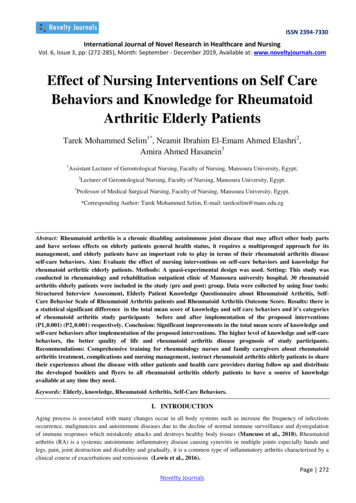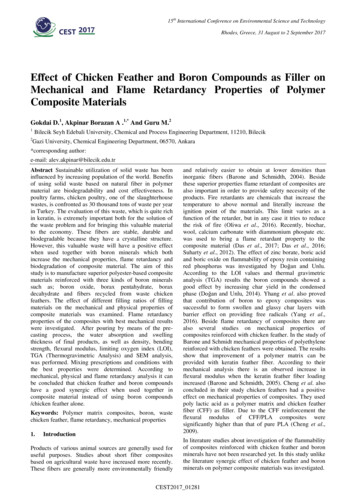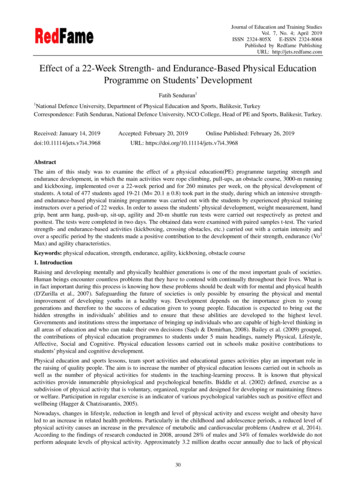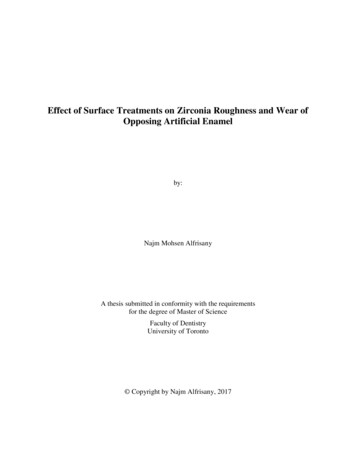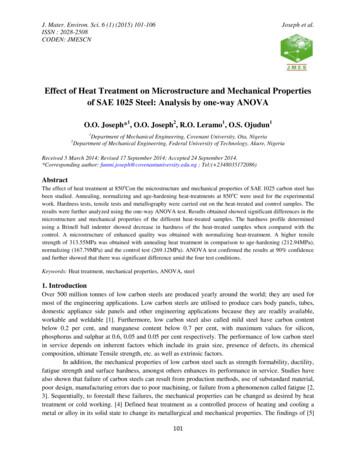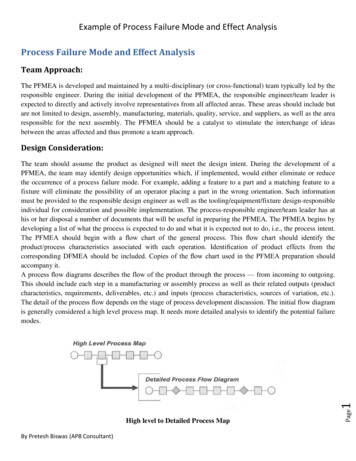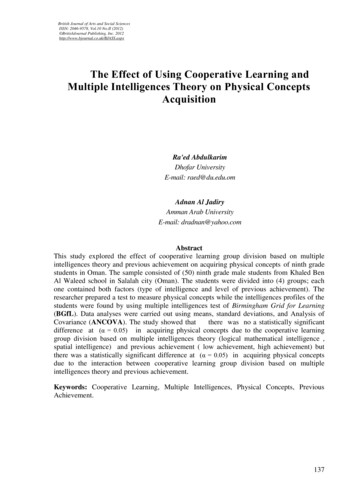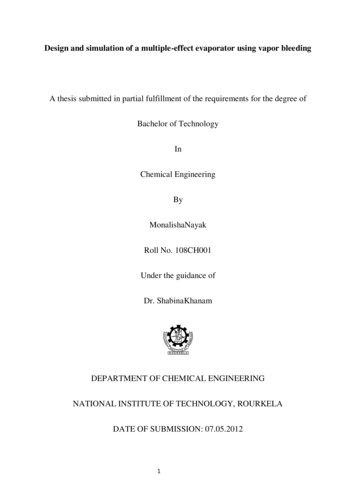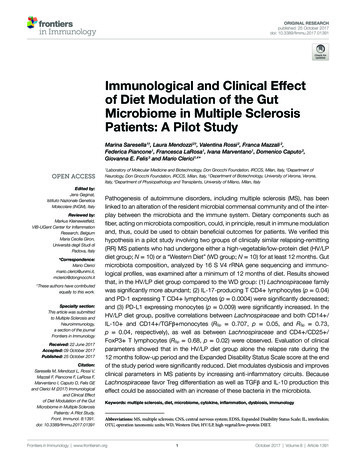
Transcription
Original Researchpublished: 25 October 2017doi: 10.3389/fimmu.2017.01391IMarina Saresella1†, Laura Mendozzi 2†, Valentina Rossi 2, Franca Mazzali 2,Federica Piancone1, Francesca LaRosa1, Ivana Marventano1, Domenico Caputo 2,Giovanna E. Felis 3 and Mario Clerici1,4*1Laboratory of Molecular Medicine and Biotechnology, Don Gnocchi Foundation, IRCCS, Milan, Italy, 2Department ofNeurology, Don Gnocchi Foundation, IRCCS, Milan, Italy, 3 Department of Biotechnology, University of Verona, Verona,Italy, 4Department of Physiopathology and Transplants, University of Milano, Milan, ItalyEdited by:Jens Geginat,Istituto Nazionale GeneticaMolecolare (INGM), ItalyReviewed by:Markus Kleinewietfeld,VIB-UGent Center for InflammationResearch, BelgiumMaria Cecilia Giron,Università degli Studi diPadova, Italy*Correspondence:Mario it†These authors have contributedequally to this work.Specialty section:This article was submittedto Multiple Sclerosis andNeuroimmunology,a section of the journalFrontiers in ImmunologyReceived: 22 June 2017Accepted: 09 October 2017Published: 25 October 2017Citation:Saresella M, Mendozzi L, Rossi V,Mazzali F, Piancone F, LaRosa F,Marventano I, Caputo D, Felis GEand Clerici M (2017) Immunologicaland Clinical Effectof Diet Modulation of the GutMicrobiome in Multiple SclerosisPatients: A Pilot Study.Front. Immunol. 8:1391.doi: 10.3389/fimmu.2017.01391Pathogenesis of autoimmune disorders, including multiple sclerosis (MS), has beenlinked to an alteration of the resident microbial commensal community and of the interplay between the microbiota and the immune system. Dietary components such asfiber, acting on microbiota composition, could, in principle, result in immune modulationand, thus, could be used to obtain beneficial outcomes for patients. We verified thishypothesis in a pilot study involving two groups of clinically similar relapsing-remitting(RR) MS patients who had undergone either a high-vegetable/low-protein diet (HV/LPdiet group; N 10) or a “Western Diet” (WD group; N 10) for at least 12 months. Gutmicrobiota composition, analyzed by 16 S V4 rRNA gene sequencing and immunological profiles, was examined after a minimum of 12 months of diet. Results showedthat, in the HV/LP diet group compared to the WD group: (1) Lachnospiraceae familywas significantly more abundant; (2) IL-17-producing T CD4 lymphocytes (p 0.04)and PD-1 expressing T CD4 lymphocytes (p 0.0004) were significantly decreased;and (3) PD-L1 expressing monocytes (p 0.009) were significantly increased. In theHV/LP diet group, positive correlations between Lachnospiraceae and both CD14 /IL-10 and CD14 /TGFβ monocytes (RSp 0.707, p 0.05, and RSp 0.73,p 0.04, respectively), as well as between Lachnospiraceae and CD4 /CD25 /FoxP3 T lymphocytes (RSp 0.68, p 0.02) were observed. Evaluation of clinicalparameters showed that in the HV/LP diet group alone the relapse rate during the12 months follow-up period and the Expanded Disability Status Scale score at the endof the study period were significantly reduced. Diet modulates dysbiosis and improvesclinical parameters in MS patients by increasing anti-inflammatory circuits. BecauseLachnospiraceae favor Treg differentiation as well as TGFβ and IL-10 production thiseffect could be associated with an increase of these bacteria in the microbiota.Keywords: multiple sclerosis, diet, microbiome, cytokine, inflammation, dysbiosis, immunologyAbbreviations: MS, multiple sclerosis; CNS, central nervous system; EDSS, Expanded Disability Status Scale; IL, interleukin;OTU, operation taxonomic units; WD, Western Diet; HV/LP, high vegetal/low-protein DIET.Frontiers in Immunology www.frontiersin.org1October 2017 Volume 8 Article 1391
Saresella et al.Effect of Diet on MSINTRODUCTIONpossibly resulting in the modulation of the immune response, wehypothesized that MS disease activity could be affected by dietarypatterns. In this pilot study, we verified this hypothesis by analyzing immune indexes, clinical parameters and gut microbiota intwo groups of MS patients who at the time of recruitment werealready following two distinct dietary regimes: a “Western Diet”(WD) and a high-vegetable/low-protein diet (HV/LP diet).Multiple sclerosis (MS) is a chronic disease of the centralnervous system (CNS) characterized by demyelination andmediated by an auto-reactive immune process directed againstcentral neural tissues. Experimental autoimmune encephalitis(EAE) is a widely used animal model of MS induced by CNSrestricted antigens (1). The ethiopathogenesis of MS is stillonly partly understood, but a number of recent publicationssuggested that alterations of the microbiota play a role in thepathogenesis of this disease (2–4). Thus, the use of a cocktailof antibiotics to alter the gut microbiota of mice prior to EAEinduction was shown to result in a significant reduction of EAEseverity. This effect was mediated by an increase of CD4 /CD25 /FoxP3 regulatory T cells (Treg) cells (5) and of regulatory CD5 /B cells (6). Even more recently, results indicatedthat EAE-resistant germ-free mice are rendered susceptibleto the disease by the introduction of segmented filamentousbacteria into their gut microbiome. This phenomenon wasthe consequence of an increased differentiation of proinflammatory Th17 cells (7). Notably, dietary supplementation withprobiotics was shown to modulate EAE secondarily to theregulation of pro- and anti-inflammatory cytokines (8–16),and engineered bacteria strains, such as Salmonella-CFA/I andHsp65-producing Lactococcus lactis, were observed to preventEAE via the production of TGFβ and IL-13 by Tregs (17–19).Finally, diet has been observed to influence EAE susceptibilityand disease activity (2). Thus, a low-calorie diet was shown tohave a beneficial effect in EAE (20), whereas a salt-rich dietresulted in an increased severity of EAE as a consequence of anupregulation of Th17 cell activity (21).The analysis of gut microbiota in MS patients is still in theearly stages (2). Recent data (22) showed that the human gutis colonized by Clostridium perfringens type B during diseaserelapse. Clostridium perfringens type B produces a toxin (ε toxin)that causes microangiopathy, resulting in the disruption ofthe blood–brain barrier (BBB) associated with neuronal andoligodendrocyte damage (23–26), possibly justifying its effectof disease activity. Additional data indicated that a mixtureof Clostridium species enhances Treg cell populations in MSpatients (27), suggesting that, besides the effect of a toxin, animbalance within Clostridium species (phylum Firmicutes)might be present in the microbiota of these patients. Moreover,the archaeal Methanobrevibacteriaceae was described to beincreased in MS patients, in whom the anti-inflammatory taxaButyricimonas (phylum Bacteroidetes) and Lachnospiraceae(phylum Firmicutes) were decreased (28). Even more recently,Faecalibacterium prausnitzii, an important butyrate-producingorganism, was observed to be reduced in MS patients in analogy to what is observed in inflammatory bowel disease, anotherautoimmune condition (29). Since butyrate upregulates Tregcell populations, these results suggest a mechanism by whichgut microbiome alterations would predispose individuals todeveloping MS.As diet plays an essential role in shaping the gut microbiome(30), and a high-fiber intake has been linked to health benefitsas a consequence of the effect of fiber on the gut microbiota (31),Frontiers in Immunology www.frontiersin.orgMATERIALS AND METHODSIndividuals Enrolled in the StudyPatients with a diagnosis of relapsing-remitting (RR) MS thatare followed by the Multiple Sclerosis Rehabilitation Unit of theDon Carlo Gnocchi Foundation in Milan, Italy, were enrolled inthis pilot trial on a voluntary basis between May and Octoberof 2016. Notably, this unit offers dietary advices to patients thatare provided by a staff of professional nutritionists. Inclusioncriteria were age 18 years and disease stability for 6 monthsprior to enrollment. Main exclusion criteria were: (1) use ofdisease modifying treatment (DMD) for 6 months prior toenrollment; (2) use of immunosuppressants or teriflunomide inthe clinical history; (3) presence of significant co-morbiditiessuch as arterial hypertension, cerebrovascular disorders, heartor pulmonary diseases, diabetes, endocrine, gastrointestinal, orpsychiatric diseases. Gender, disease duration, and disabilitylevel, as assessed by the Kurtzke Expanded Disability Status Scalescore (EDSS), relapse rate and other neurological indices werenot used as inclusion/exclusion criteria but were recorded duringthe initial neurological examination.Twenty-nine patients were initially selected for the study; allthe patients underwent a face-to-face interview with a team ofprofessional nutritionists who assessed the dietary regimen thathad been followed for at least a 12-months period. This periodwas selected because it was considered to be a valid way to assessthe adoption of a stable dietary habit. Nine of the initially selectedpatients were not enrolled in the study because adherence toclear dietary patterns could not be unequivocally identified. Ofthe remaining 20 patients, 10 (7 females and 3 males; medianage 43, IQ 40–44) had chosen to follow a diet characterizedby the use of fresh fruits and vegetables, legumes, nuts, wholegrains, and extra virgin olive oil and a very limited use of animalproteins, including fish (no more than twice a week), poultry (nomore than once a week), eggs (no more than four eggs a week),and dairy products (no more than once a week), as well as a lowintake of refined cereals, salt, sugar, fried food and the exclusionof alcohol, red meat, saturated fats of animal origin, and trans-fats(e.g., processed dressing). This diet was labeled as high vegetable/low protein (HV/LP diet). The remaining 10 patients (8 femalesand 2 males; median age 49, IQ 45–52) were following a classical Western Diet (WD) characterized by the regular consumptionof red meat, processed meat, refined grains, sweetened food, salt,and an overall high intake of saturated and omega-6 fatty acids(32). These 20 patients were enrolled in the study. Adherence tothe two different dietary regimens was verified in a face-to-faceinterview with the professional nutritionists every 4 months. Nouse of any type of antibiotic or of pre- and probiotics was reported2October 2017 Volume 8 Article 1391
Saresella et al.Effect of Diet on MSduring the study period. Blood and fecal samples were collectedat enrollment, i.e., after at least 1 year of either WD or HV/LP diet;neurological examinations were performed at enrollment and atthe 12 months follow-up point.The study protocol was approved by the ethics committee ofthe Don Carlo Gnocchi Foundation and all the enrolled patientssigned an informed consent.22 mW Blue Solid State Diode laser operating at 488 nm and witha 25 mW Red Solid State Diode laser operating at 638 nm, andinterfaced with Kaluza analysis software. Two hundred thousandcells were acquired and gated on lymphocyte and monocyte FSCand SSC properties. Isotype control or single fluorochromestained preparations were used for color compensation.Microbiome AnalysesBlood Sample Collection andCell SeparationAt enrollment, participants were asked to collect their first morning stool at home using an adequate stool collection container(Biosigma, VE, ITALY). Samples were shipped, within 1 h, on icepacks to the Laboratory of the Don Carlo Gnocchi Foundation inMilan, where they were immediately stored at 80 C. Finally, thestored total stool samples were sent on dry ice by FedEx deliveryto the processing facility (Second Genome Inc., San Francisco,CA, USA).DNA isolation, library preparation, and sequencing as wellas data analysis were performed by Second Genome Inc. Briefly,nucleic acid isolation with the MoBio PowerMag Microbiomekit (Carlsbad, CA, USA) and quantified via the Qubit Quant-iTdsDNA High Sensitivity Kit (Invitrogen, Life Technologies, GrandIsland, NY). Samples enriched in bacterial 16 S V4 rDNA regionand incorporating Illumina (San Diego, CA, USA) adapters andindexing barcodes, by PCR, were concentrated using a solidphase reversible immobilization method for the purification ofPCR products, quantified by qPCR and sequenced with MiSeq instrument. Amplicons were sequenced for 250 cycles withcustom primers designed for paired-end sequencing. Operationtaxonomic units (OTU) were selected using an in-house pipelineof analysis and sequences hitting a unique strain with an identity 99% were assigned a strain OTU. To ensure specificity of thestrain hits, a difference of 0.25% between the identity of thebest hit and the second best hit was required (e.g., 99.75 vs. 99.5); achimera filtering and discard was also used. Representative OTUsequences were assigned taxonomic classification via mothur’sBayesian classifier, trained against the Greengenes referencedatabase of 16 S rRNA gene sequences clustered at 99%.As for alpha-diversity (within sample diversity), observeddiversity (number of unique OTU) and Shannon Index (whichutilizes the richness of a sample along with the relative abundanceof the present OTUs to calculate a diversity index) were the metrics used.Sample-to-sample dissimilarity (beta diversity) was also deter mined. All profiles are inter-compared in a pair-wise fashion todetermine a dissimilarity score and store it in a distance dissimilarity matrix. Distance functions produce low dissimilarity scoreswhen comparing similar samples. Abundance-weighted samplepair-wise differences were calculated using the Bray–Curtis dissimilarity (ratio of the summed absolute differences in counts tothe sum of abundances in the two samples) (33). The binary dissimilarity values were calculated with the Jaccard index (metriccomparing the number of mismatches, i.e., OTUs present in onebut absent in the other, in two samples relative
grains, and extra virgin olive oil and a very limited use of animal proteins, including fish (no more than twice a week), poultry (no more than once a week), eggs (no more than four eggs a week), and dairy products (no more than once a week), as well as a low intake of refined cereals, salt, sugar, fried food and the exclusion




